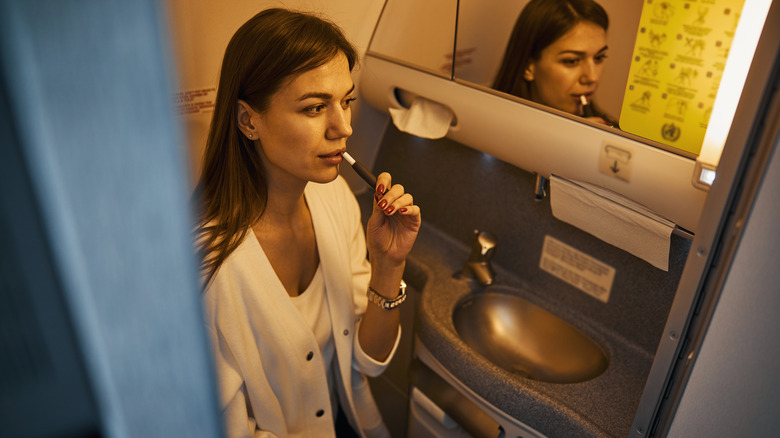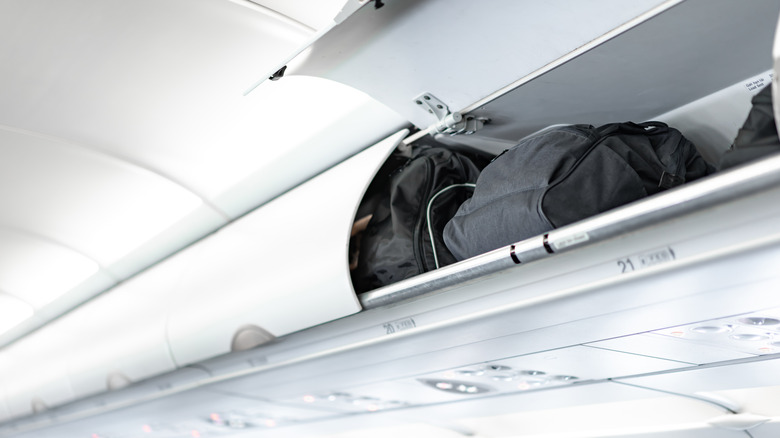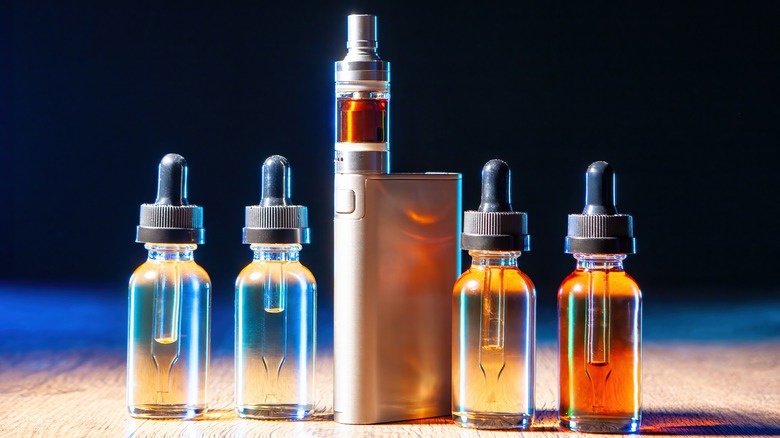What Really Happens If Someone Were To Vape On A Plane
Smoking has seen a resurgence in recent years, thanks to electronic cigarettes or vapes. But like traditional smoking, vaping on airplanes is prohibited and has been since 2016. This regulation was enacted to limit vulnerable passenger's exposure to smoke. Moreover, vapes — which can be rechargeable — feature highly flammable lithium batteries. Despite this, passengers, per The Cut, have admitted to sneakily vaping in the plane's bathroom. In other cases, passengers have been brazenly captured on social media vaping on a plane. So, what happens if an individual uses their vape during a flight and gets caught? As you can imagine, nothing good.
This scenario can play out in different ways. For example, they might have to pay a hefty fine. However, passengers could face severe repercussions. In September 2023, a man on a Jet2 flight leaving Manchester, England, was seen vaping by crew members. He refused to stop vaping and was ultimately arrested. The flight was canceled as well. The flight could also continue without said vaping passenger, or worse — passengers could be banned from the airline for life. This is what happened when a passenger vaped in the bathroom on a Spirit Airlines flight in 2019.
In October 2023, a man on a Jetstar flight vaped in the airplane bathroom. This caused the fire alarm to go off, and he was promptly booted off the flight. Note that a vape setting off a smoke detector could cause severe delays. To be clear, while vaping on planes is prohibited, flying with a vape is not.
The dangers of vapes on a plane
Lithium batteries in vapes pose a fire risk due to their chemical composition. Speaking to CBS News, Deke Ezekoye from the University of Texas Fire Research Group (UTFRG) stated, "As the failure (of the battery) occurs... all of those things will start heat generation within the cell as the heat generates." He added, "Within the cell, there's a process called 'thermal runaway' that occurs." As K.M. Abraham from Northeastern University further explained to Consumer Reports, the battery can then explode, and the chemicals inside combine with oxygen, resulting in a fire.
Unfortunately, vapes and their lithium batteries have been known to start fires on planes. In March 2023, a Spirit Airlines flight was heading to Orlando from Dallas when a fire broke out in an overhead bin. A retired firefighter, Rocco Chierichella, happened to be on the flight and helped extinguish the fire. In an interview with Action News Jax, Chierichella revealed that he believed a defective vape battery caused the incident. Chierichella and others were injured, and the flight made an emergency landing in Jacksonville.
Shortly after, in May 2023, a fire broke out in an overhead bin during a flight from Geneva to Amsterdam. Again, the culprit was a vape, and passengers successfully extinguished the fire. However, these occurrences are not out of the ordinary. An analysis by CBS News of data reported by the Federal Aviation Administration (FAA) shows that flight disturbances caused by lithium batteries have been occurring weekly since 2021.
Tips for traveling with a vape
If you're bringing your vape on your next trip, don't make these security mistakes that could slow you down. First and foremost, vapes are not allowed in checked luggage. This is to reduce the possibility of the vape accidentally turning on. Always pack your vape in your carry-on bag — and do so carefully. The Federal Aviation Administration (FAA) states that passengers should take out the vape's lithium batteries, which must also be placed in their carry-on bags. Speaking of, the FAA states that each lithium battery cannot have more than 100 watt-hours. Likewise, each lithium battery should not be more than two grams.
Note that you are also not allowed to charge your vape in an airplane. FAA advises storing the device and its heating coil in a protective case. Again, this will lessen the chances of the vape accidentally turning on. If you have E-liquid, know it is not exempt from the TSA's 311 liquid rule. Either place it in your checked bag or ensure the liquid does not exceed 3.4 ounces. Some other things to keep in mind: If you need to vape before your flight, do so at a designated smoking area. If you're traveling to a different country, make sure to check if vaping is allowed at your destination.
Moreover, if you plan on bringing more than one vape, contact your airline to find out how many are allowed. If you follow these rules, you shouldn't get flagged by TSA. While regulations regarding lithium batteries seem stringent, this is all to keep everyone on board safe.


